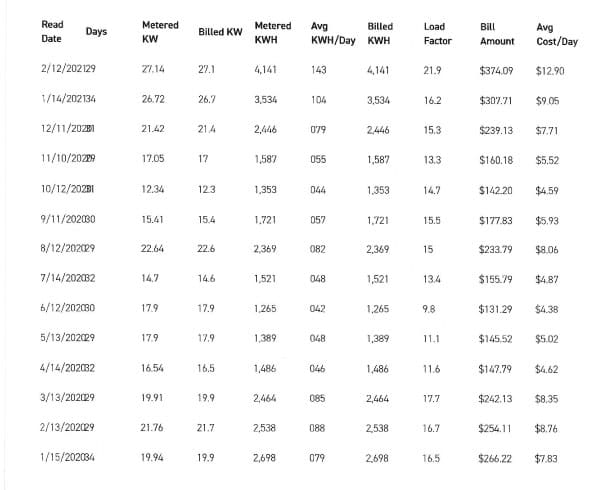Does your business have high utility bills? Are your company’s mechanical systems needing repair or replacement? Or are you considering being more sustainable, implementing renewable energy like commercial solar panels? If either of these is true, a commercial energy audit would be right for you. What goes into a commercial energy audit, how much do commercial energy audits cost, and how will getting one benefit your company?
The energy audit process
Commercial energy audits are only useful if they take a holistic view of your building, evaluating all energy systems you have in addition to evaluating utility data. Combining quantitative data with the qualitative data found on-site is the best pathway to discovering opportunities to improve your company’s operations.
1. Review Historic Utility Bills
To begin our process, we collect facility’s historic utility bills to determine the facility’s annual energy consumption. These typically come in the form of an CSV spreadsheet or PDF table and can easily be requested via email or phone from your utility company. Having one year’s worth of utility history is most ideal so our engineers on staff can see energy usage in the winter and summer, where heat and air conditioning are used most (which usually results in higher utility bills).
Here’s a sample of what you should expect your utility history to look like. Notice that it highlights kWh (usage) and kW (demand) consumption. These are the two big data points commercial energy auditors will look at. If your company is actually charged for energy demand consumption, there is a lot of room to eliminate that with products like commercial solar panels.

2. Evaluate Existing Energy Systems
Next, an energy auditor will perform a walkthrough of your facility to collect on-site qualitative data. Typically this is done with your designated facility manager so the walkthrough can go as smoothly and quickly as possible. Your auditor will look at the following systems:
Mechanical Systems
HVAC units, boilers, hot water heaters, chillers, and more are assessed to determine current state of equipment, age, life expectancy, and performance. Your auditor will take notes or pictures of model numbers and spec plates to see if you could benefit from installing upgraded mechanical systems.
Interior and Exterior Lighting
Many older facilities still have compact fluorescent or incandescent light bulbs, which uses significantly more energy. Your commercial energy auditor will look at every lighting fixture (if permission is given to walk through each room) to get the most accurate lighting count. This is so key because, if some or all lights are not using LED technology, switching them can result in savings of up to 30%.
Thermal Boundaries
The building envelope (windows, insulation, roofs, etc.) seal is essential to keep your conditioned spaces from leaking air. Ensuring proper insulation throughout the facility is key to minimizing heating and cooling costs. Your auditor will assess each area thoroughly to check for poorly insulated areas.
Miscellaneous Systems
Every facility is custom and operates differently. If your facility has other energy systems such as geothermal pumps, those special systems can and will be evaluated by energy auditors. Getting a full picture of every single energy system is imperative, so unconventional or uncommon systems will be checked.
3. Reporting
After the audit is complete, you will receive a report pinpointing pain points in your energy systems along with suggested solutions to address those problems. The report will be based on the combination of the qualitative data collected from the audit (ex: mechanical system model numbers) and the quantitative data collected from utility history. Your auditor should have a certified engineer on staff who is qualified to disseminate this information and derive meaningful insights to help your company achieve your goals of being more sustainable, lowering utility costs, or fixing/replacing mechanical systems.
How much do commercial energy audits cost?
Many Energy Service Companies (ESCOs) will offer a comprehensive energy audit to look at all of the above factors free of charge if serious interest is there to have your building evaluated. Auditing firms will charge for the service and will have tiers of audit levels which get more complex and expensive as their get higher; these are called ASHRAE energy audits (level 1, level 2, and level 3). Auditing firms may charge anywhere from $0.10 to $0.20 or more per square foot of your building, depending on the complexity of the audit and the ASHRAE audit level you choose.
Click here for a full explanation of the ASHRAE energy audit levels ->
Want an energy audit for your building?
EnergyLink offers a free commercial energy audit to building owners in the United States. As a NAESCO certified commercial energy auditor, EnergyLink’s team is trained to help property owners and facility managers better understand their buildings and discover the greatest opportunities for energy savings.
We specialize in energy management solutions for things like solar energy systems, HVAC, lighting, building automation systems, and much more. The energy audit process allows us to determine what systems are causing you the most money on your utility bills.






